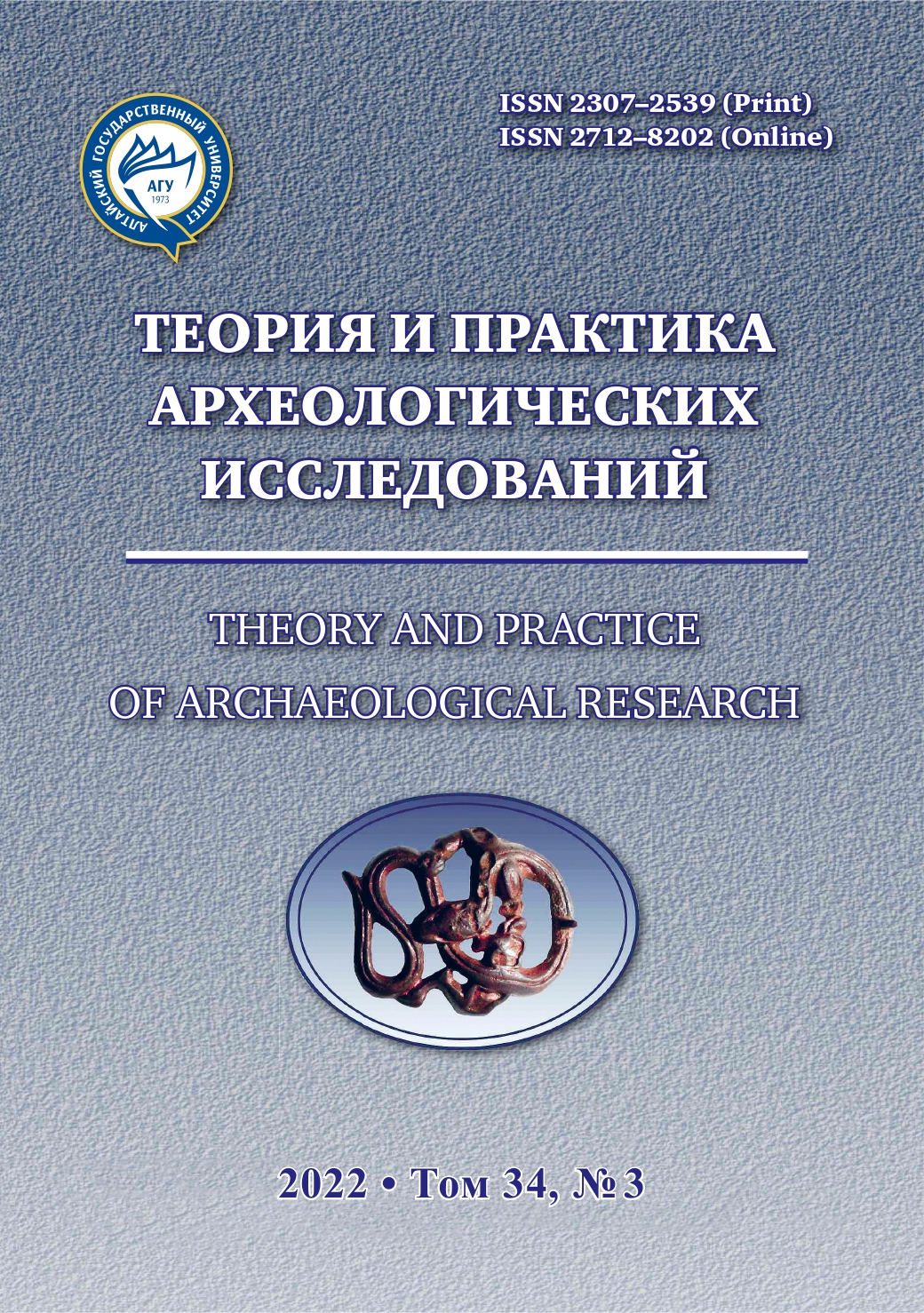REVIEW OF PRELIMINARY RESULTS OF ARCHAELOGICAL RESEARCH IN THE AREA OF MOUNT AIYRTAS IN 2022, CENTRAL KAZAKHSTAN
Abstract
The mountainous area of Aiyrtas is located in the Karkaraly district of the Karaganda region. There, in previous years, the fi rst sites of the early Iron Age were discovered and explored. Among them, eight mounds from three burial grounds were excavated, and settlements of the early Iron Age, Kazakh winterings were also found. In the summer of 2022, under the guidance of the author, a strip 2.6 km long was identifi ed on the upper slope of the mountain, where 8 settlements of the early Iron Age are compactly located. Excavations of the Aiyrtas-3 settlement were carried out. On an area of 432 m2, remains of stone foundations of dwellings and outbuildings were discovered, which, judging by the finds of stone tools and ceramics, belong to two historical eras: the Late Bronze Age and the Saka period. At the same time, questions of the chronology of the upper level of buildings (structures 1–3) will becorrected in the course of obtaining the results of radiocarbon analyses. A few iron objects are associated with the top layer of the site. In the course of research, old Kazakh winterings were discovered, among which, as the author believes, there are earlier ones than those studied in previous years.
Downloads
Metrics
No metrics found.
References
Abdulganeyev M. T., Vladimirov V.N. Typology of Altai Settlements in the 6th–2nd Centuries BC. Barnaul : Izd-vo Alt. un-ta, 1997. 148 p. (In Russ.).
Azhigali S. Ye., Turganbayeva L. R. Kainar Cult-Housing Complex of the Second Half of the 18th — Early 20th Centuries in Northern Ustyurt as a Historical, Cultural and Architectural Monument. Arheologiya, etnografi ya i antropologiya Evrazii = Archaeology, Ethnography and Anthropology of Eurasia. 2021;49(4):109–119 (In Russ.).
Beisenov A. Z. Issues of the Study and Preservation of Kazakh Winterings. In: Preservation and Study of the Cultural Heritage of the Altai Territory. Barnaul : Izd-vo Alt. un-ta, 2021a. Issue. ХХVII. Pр. 7–16 (In Russ.)
Beisenov A. Z., Akhiyarov I. K., Dzhumanazarov N. SH. Karashoky, an Old Wintering Place in the Aksary Valley in Central Kazakhstan. In: Field Research in the Upper Ob, Irtysh and Altai (archaeology, ethnography, oral history and museology. 2019. Barnaul : AltGPU, 2020. Issue. 15. Pр. 6–25 (In Russ.).
Beisenov A. Z., Gimranov D. O., Akhiyarov I. K., Duysenbay D. B. Settlement of the Saka Time Abylai in Central Kazakhstan. Teoriya i praktika arheologicheskih issledovanij = Theory and practice of archaeological research. 2018;2:150–171 (In Russ.)
Beisenov A. Z., Gorashchuk I. V., Duysenbay D. B. Trasological Study of Stone Tools of the Settlement of the Saka Time of Abylai, Central Kazakhstan. Povolzhskaya arheologiya = The Volga Region Archaeology. 2021;3:177–194 (In Russ.).
Beisenov A. Z., Ismagulova A. O., Kitov E. P., Kitova A. O. Th e Population of Central Kazakhstan in the 1st Millennium BC. Almaty : Institut arheologii, 2015. 188 p. (In Russ.).
Beisenov A. Z., Loman V. G., Shashenov D. T. Ceramics from the New Kurgans of the Tasmola Culture. Nizhnevolzhskij arheologicheskij vestnik = The Lower Volga Archaeological Bulletin. 2022;21(1):6–20. DOI: https://doi.org/10.15688/nav.jvolsu. 2022.1.1 (In Russ.)
Beisenov A. Z., Shashenov D. T. Tasmola Burial Mounds in the Aiyrtas Valley in Central Kazakhstan. Nizhnevolzhskij arheologicheskij vestnik = The Lower Volga Archaeological Bulletin. 2020;19(1):268–284. DOI: https://doi.org/10.15688/nav.jvolsu.2020.1.15. (In Russ.)
Beisenov A. Z., Shashenov D. T., Duysenbay D. B. Kyzylshilik, Wintering of Khasen Akaev’s Family. In: Preservation and Study of the Cultural Heritage of the Altai Territory. Barnaul : Izd-vo Alt. un-ta, 2020. Issue. XXV. Pp. 240–251 (In Russ.).
Beisenov A. Z., Shulga P. I., Loman V. G. Settlements of the Saka Era. Almaty : NICIA “Begazy-Tasmola”, 2017. 208 p. (In Russ.).
Burzhua Zh., Cheremisin D. V., Plets G., Dvornikov E. P., Ebele’ A. V., Stikhel’baut V., Van Khoof L., Geyli V. Archaeological Landscape of the Dzhazator Valley (Altai): Monuments and Petroglyphs of the Neolithic — Ethnographic Time. Arheologiya, etnografi ya i antropologiya Evrazii = Archeology, Ethnography and Anthropology of Eurasia. 2014;4:106–119 (In Russ.).
Varfolomeyev V., Loman V., Yevdokimov V. Kent is a Bronze Age City in the Center of the Kazakh Steppes. Astana : Kazahskij nauchno-issledovatel’skij institut kul’tury, 2017. 338 p. (In Kazakh, Russian, English).
Loman V. G. Dongal Type of Ceramics. Issues of Periodization of Archaeological Sites of Central and Northern Kazakhstan. Karaganda : KarGU, 1987. Pp. 115–129 (In Russ.).
Rogozhinskiy A. E. Petroglyphs of the Archaeological Landscape of Tamgaly. Almaty : KazNII kul’turnogo naslediya, 2011. 342 p. (in Russian, English).
Soyenov V. I., Konstantinov N. A., Soyenov D. V. Features of Topography and Chronology of Altai Settlements of. In: Terra Skithica. Novosibirsk : Izd-vo In-ta arheologii i etnografi I SO RAN, 2011. Pp. 252–260 (In Russ.).
Stepanova N. F., Frolov Ya. V. Ceramics from the Settlements of the Early Iron Age in the Forest-Steppe Altai. Teoriya i praktika arheologicheskih issledovanij = Theory and Practice of Archaeological Research. 2017;1:71–85 (In Russ.).
Shagirbayev M., Ganieva A., Sakenov S. Th e Economy of the Kazakhs of the Nura-Ishim Interfl uve in the 19th — Early 20th Centuries (according to osteological materials of wintering Bozok II). Arheologiya Kazakhstana = Archaeology of Kazakhstan. 2022;1(15):146–163. DOI: 10.52967/ akz2022.1.15.146.163. (in Kazakh).
Shul’ga P. I. Cattle Breeders of Gorny Altai in the Scythian Time (based on materials from settlements). Novosibirsk : NGU, 2015. 336 p (In Russ.).
Bradley R. An Arc haeology of Natural Places. L. : Routledge, 2000. 177 p.
Butzer K. Archaeology as Human Ecology. Method and Theory for a Contextual Approach. Cambridge : Cambridge University Press, 1982. 364 p.
Chang C. Rethinking Prehistoric Central Asia: Shepherds, Farmers, and Nomads. 2018. Abingdon & New York : Routledge. 160 p.
Beisenov A. Z. New Data in the Research of the Saka Time Settlements in Central Kazakhstan. Teoriya i praktika arheologicheskih issledovanij = Theory and Practice of Archaeological Research. 2021b;33(3):181–202. DOI: 10.14258/tpai(2021)33(3).-11
Jacobson-Tepfer E., Meacham J. Archaeology and Landscape in the Mongolian Altai: An Atlas. California : ESRI Press, 2010. 209 p.
Theory and Practice of Archaeological Research is a golden publisher, as we allow self-archiving, but most importantly we are fully transparent about your rights.
Authors may present and discuss their findings ahead of publication: at biological or scientific conferences, on preprint servers, in public databases, and in blogs, wikis, tweets, and other informal communication channels.
Theory and Practice of Archaeological Research allows authors to deposit manuscripts (currently under review or those for intended submission to ABS) in non-commercial, pre-print servers such as ArXiv.
Authors who publish with this journal agree to the following terms:
- Authors retain copyright and grant the journal right of first publication with the work simultaneously licensed under a Creative Commons Attribution License (CC BY 4.0) that allows others to share the work with an acknowledgement of the work's authorship and initial publication in this journal.
- Authors are able to enter into separate, additional contractual arrangements for the non-exclusive distribution of the journal's published version of the work (e.g., post it to an institutional repository or publish it in a book), with an acknowledgement of its initial publication in this journal.
- Authors are permitted and encouraged to post their work online (e.g., in institutional repositories or on their website) prior to and during the submission process, as it can lead to productive exchanges, as well as earlier and greater citation of published work (See The Effect of Open Access).








2.jpg)




